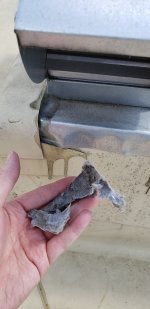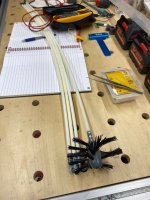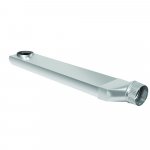GoingMyWay
Member
On Saturday I noticed that the dryer was taking an extremely long time to dry the clothes. Normally the dryer finishes around the same time as the washing machine. The washing machine said 14 minutes left, but the dryer said 1 hour 10 minutes! I think the full dryer cycle is normally just under 1 hour. I asked my wife if she ran a different dryer cycle by mistake, but she did not so I feared that there might be something wrong with the dryer itself. I could see a lot of humidity inside of the dryer, but I kinda assumed it was because it was also a little humid outside. The house had a slight fragrance of Tide detergent - normally you can smell when someone else is doing laundry when you're outside walking. The clothes were eventually coming out dry, just taking an extremely long time to finish. The lint trap also had zero lint attached to it after running 2-3 loads.
I decided to pull the flexible exhaust vent off the back of the dryer while it was still running. I was immediately hit with warm moist air so that ruled out any blockage or problem with the dryer itself. I stuck my arm down the exhaust pipe and discovered it was completely filled with water! The flexible vent had bent down just like a P trap under the sink! No wonder the dryer wasn't able to exhaust properly!
This is the nasty water that was stuck inside of the pipe.
[attachimg=1]
The dryer vents out through the roof so I climbed up there to see what might have allowed the water to get into the dryer vent in the first place. The vent was closed in the down position, but there was this caked on lint that was able to catch and hold the vent open.
[attachimg=2]
My guess is that the vent must have gotten stuck open last week when doing laundry. We had about 3 days of bad storms so the rain must have somehow been driven down into the open vent. I'm still a little skeptical how that much water got down there, but wind driven rain does make it feel almost like it's raining sideways. Water could have also slowly infiltrated over time and just this last week was enough water to completely block the vent.
I know you're supposed to routinely check the dryer exhaust venting and actually clean it out anyway, but I wonder how many people actually bother to do that.
I decided to pull the flexible exhaust vent off the back of the dryer while it was still running. I was immediately hit with warm moist air so that ruled out any blockage or problem with the dryer itself. I stuck my arm down the exhaust pipe and discovered it was completely filled with water! The flexible vent had bent down just like a P trap under the sink! No wonder the dryer wasn't able to exhaust properly!
This is the nasty water that was stuck inside of the pipe.
[attachimg=1]
The dryer vents out through the roof so I climbed up there to see what might have allowed the water to get into the dryer vent in the first place. The vent was closed in the down position, but there was this caked on lint that was able to catch and hold the vent open.
[attachimg=2]
My guess is that the vent must have gotten stuck open last week when doing laundry. We had about 3 days of bad storms so the rain must have somehow been driven down into the open vent. I'm still a little skeptical how that much water got down there, but wind driven rain does make it feel almost like it's raining sideways. Water could have also slowly infiltrated over time and just this last week was enough water to completely block the vent.
I know you're supposed to routinely check the dryer exhaust venting and actually clean it out anyway, but I wonder how many people actually bother to do that.





